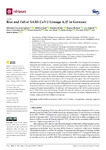Rise and Fall of SARS-CoV-2 Lineage A.27 in Germany
Calvignac-Spencer, Sébastien
Budt, Matthias
Huska, Matthew
Richard, Hugues
Leipold, Luca
Grabenhenrich, Linus
Semmler, Torsten
von Kleist, Max
Kröger, Stefan
Wolff, Thorsten
Hölzer, Martin
Here, we report on the increasing frequency of the SARS-CoV-2 lineage A.27 in Germany
during the first months of 2021. Genomic surveillance identified 710 A.27 genomes in Germany as
of 2 May 2021, with a vast majority identified in laboratories from a single German state (Baden Wuerttemberg, n = 572; 80.5%). Baden-Wuerttemberg is located near the border with France, from
where most A.27 sequences were entered into public databases until May 2021. The first appearance
of this lineage based on sequencing in a laboratory in Baden-Wuerttemberg can be dated to early
January ’21. From then on, the relative abundance of A.27 increased until the end of February but has
since declined—meanwhile, the abundance of B.1.1.7 increased in the region. The A.27 lineage shows
a mutational pattern typical of VOIs/VOCs, including an accumulation of amino acid substitutions in
the Spike glycoprotein. Among those, L18F, L452R and N501Y are located in the epitope regions of the
N-terminal- (NTD) or receptor binding domain (RBD) and have been suggested to result in immune
escape and higher transmissibility. In addition, A.27 does not show the D614G mutation typical
for all VOIs/VOCs from the B lineage. Overall, A.27 should continue to be monitored nationally
and internationally, even though the observed trend in Germany was initially displaced by B.1.1.7
(Alpha), while now B.1.617.2 (Delta) is on the rise.
Dateien zu dieser Publikation

